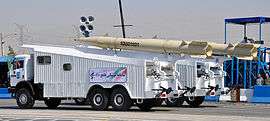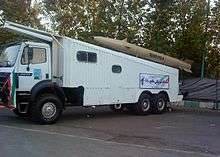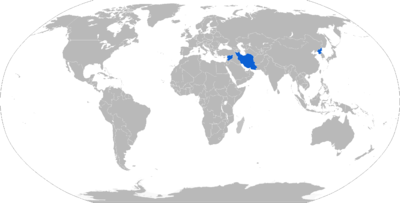Fateh-110
| Fateh 110 | |
|---|---|
|
Fateh-110 missiles on Zolfaghar TEL in a parade | |
| Type | Tactical SRBM |
| Service history | |
| In service | 2002–present |
| Used by |
Hezbollah |
| Wars | Syrian civil war |
| Production history | |
| Manufacturer | Iran |
| Unit cost | Unknown |
| Specifications | |
| Weight | 3,450 kg |
| Length | 8.86 m |
| Diameter | 0.61 m |
| Warhead | One |
| Blast yield | Not applicable |
|
| |
| Engine | Solid (single stage) |
Operational range | 300 km |
| Speed | Mach 3.5 |
Guidance system | Inertial & electro-optical terminal |
| Accuracy | 250 meters CEP [1] |
Fateh-110 (Persian: فاتح-۱۱۰, "conqueror") is a single-stage solid-propellant, surface-to-surface missile with at least a 200 km range, and it is produced domestically within Iran by the Aerospace Industries Organization, including the solid fuel propellant. Iran successfully flight tested the final version of the Fateh-110 in September, 2002. Several weeks later in mid-September 2002 the Aerospace Industries Organization opened a plant to mass-produce the Fateh-110. The initial range of the missile was 200 km but in September 2004 it was announced that it had been extended to 250 km and if needed it could be increased further. Fateh-110 has a range of 300 km in its fourth generation which was unveiled in 2012.[2]
History
After the Iran-Iraq war, Iran found out that it needed an accurate short-range missile, as its Zelzal and Naze'at rockets were unguided rockets and thus very inaccurate. Thus, 200 Chinese CSS-8 short-range missiles were bought in 1989.[3] But those missiles did not satisfy Iranians because of their short range, relatively light warhead and bulky structure. So a project was assigned to Shahid Bagheri Industries to design and produce a guided short-range missile.

Developments began in 1995 and Zelzal 2 was chosen for the basis of the missile. Reportedly Syria also joined the program and produced its version called M-600. North Korea also gained some missiles.[4] First tests occurred in 2002 which were successful, and the missile was put into production.
In 2004, a version with extended range of 250 km was unveiled. This version is probably the one offered for export.[5]

It seemed that Syrians were still trying to produce their M-600 in 2008 based on the version unveiled in 2004.[6] In 2010 the Israeli press claimed that Syria has given hundreds of M-600 missiles to Hezbollah.[7]
In 2010, an upgraded version, dubbed "Third Generation of Fateh-110" was tested by Iran. Iranian defense minister Ahmad Vahidi stated that accuracy, range, reaction time and storage capability in different parts of the country are increased. After that Iranian TV provided footage of the test and the impact.[8] Some time later, it was delivered to IRGC.[9] The range of the missile was stated as 300 km.[10]
In 2011, Iran unveiled its first anti-ship ballistic missile called Khalij Fars. It is clearly based on Fateh-110 and shares the range of 300 km with the later versions.
On August 2012 Iran successfully test-fired the fourth generation of Fateh-110 missiles.

On 3 and 5 May 2013, Israel claimed it had hit an alleged shipment of Fateh-110 in Syria that it claimed were "destined for Hezbollah". Israel said that it would not tolerate "game changing weapons" falling into the hands of Hezbollah.[11][12] On 18 May Israeli media claimed that the Syrian army had aimed a battery of Tishreen missiles, Syria's version of Iran’s Fateh-110, at Tel Aviv according to reconnaissance satellites. These missiles are believed to see possible use as a deterrent against further Israeli airstrikes on Syrian targets.[13]
In late November 2014, Iranian and Lebanese sources confirmed that Hezbollah had received Iranian Fateh-110 guided ballistic missiles and inducted them into their missile arsenal. With a 250–350 km (160–220 mi) range, Fateh-110 missiles fired from Lebanon could hit targets anywhere in Israel up to the northern Negev. Israel has regarded deliveries of such missiles as justification for preemptive response, as the previous year it attacked missile shipments, transport convoys, and storage sites in Syria and Lebanon to prevent these and other missile types from being acquired by Hezbollah.[14]
Design
Missile body is very similar to that of Zelzal 2. It has the same diameter of 610 mm and a length of 8.86 m.
It has three sets of fins. Four at the end of it near the exhaust, four other triangular shaped fins just above them and four small ones in front of missile near the nosecone. Of the three sets of fins on the missile, only the front ones are movable.
Transporting
Fateh 110 uses three different TELs. The first one has a similar mechanism with SA-2 and is based on a Mercedes-Benz 6x6 truck. The second one is the TEL that is used by newer versions of Zelzal rockets that again uses the Mercedes-Benz platform. The third one is a new indigenous TEL called Zolfaghar that is able to carry two missiles instead of one.
Variations
| Variant | Range | Warhead Weight | Speed | Notes |
|---|---|---|---|---|
| Fateh-110 | 200 km | 650 kg | Mach 3.5 | First variant |
| Fateh-110 Second Generation | 250 km | 450 kg | Mach 3.7 | Announced in 2004 |
| Fateh-110 Third Generation | 300 km | 650 kg | Mach 3 | Announced in 2010. Reports say that accuracy is also increased.[15] |
| Fateh-110-D1 (Fourth Generation) | 300 km | 650 kg | Mach 3 | Addition of a new guidance system with "100% precision". Shown in 2012.[16] |
| Khalij Fars | 300 km | 650 kg | Mach 3 | Anti-ship ballistic missile based on Fateh-110. Unveiled in 2011.[17] |
| M-600 or Tishreen | 250 km | 450 kg | Mach 3.7 | Syrian variant |
| Fateh-313 | 500 km | - | - | Successor to Fateh-110 versions.[18] |
| Zolfaghar | 750 km | - | - | newest version with multiple reentry vehicle (MRV) warhead unveiled in 2016.[19] |
Combat record
Syrian civil war
According to two unnamed U.S. military officials, the Syrian Government has fired at least two Fateh A-110 missiles in late December 2012. The firing of these missiles appeared to be an effort to more precisely target Syrian rebels.[20]
Operators

 Iran
Iran Syria
Syria North Korea
North Korea- Hezbollah
See also
- Zelzal-1
- Zelzal-2
- Zelzal-3
- Military of Iran
- Iran's missile forces
- Iranian military industry
- Current Equipment of the Iranian Army
References
- ↑ http://missilethreat.csis.org/missile/fateh-110/
- ↑ http://english.farsnews.com/newstext.php?nn=9104254711
- ↑ "Tondar 69 (CSS-8) (Iran)". IHS Jane's. Retrieved 2012-08-09.
- ↑ "Fateh A-110". MissileThreat.csis.org. Retrieved 2012-08-09.
- ↑ "MXF05-000350 Fateh-110 Surface to Surface Missile". Modlex. Retrieved 2012-08-09.
- ↑ "Fateh A-110". CSIS Missile Threat. Retrieved 13 November 2014.
- ↑ Yaakov Katz, Rebecca Anna Stoil (2010-05-06). "Hizbullah received hundreds of Syrian missiles". The Jerusalem Post. Retrieved 2012-08-09.
- ↑ http://www.tabnak.ir/fa/pages/?cid=116337
- ↑ http://www.mehrnews.com/fa/NewsDetail.aspx?NewsID=1155522
- ↑ "سردار حاجيزاده اعلام كرد: برد نسل سوم موشك فاتح 110 به 300 كيلومتر رسيده است". Retrieved 13 November 2014.
- ↑ "Israel confirms airstrike inside Syria.". Retrieved 13 November 2014.
- ↑ "Syria warns Israel after 'latest air raids'.". Retrieved 13 November 2014.
- ↑ http://www.haaretz.com/news/diplomacy-defense/report-assad-preparing-missile-strike-against-tel-aviv-in-case-attacked-again-1.524664 Report: Assad preparing missile strike against Tel Aviv in case attacked again May.19, 2013
- ↑ Iran: We supplied ballistic guided rockets to Hezbollah - Defense-Update.com, 24 November 2014
- ↑ http://english.farsnews.net/newstext.php?nn=8906031433
- ↑ http://english.farsnews.com/newstext.php?nn=9104252685
- ↑ http://english.farsnews.com/newstext.php?nn=8911181179
- ↑ Iran Doubles ‘Fateh’ Guided Missile’s Range to 500km - Defense-Update.com, 22 August 2015
- ↑ http://www.farsnews.com/newstext.php?nn=13950631000684 - Iranian parade 2016
- ↑ Barbara Starr (2012-12-28). "U.S. officials: Syria using more accurate, Iranian-made missiles". CNN. Retrieved 2013-02-08.
External links
- CSIS Missile Threat - Fateh 110
- Info Page on Fatah 110 by Israel Missile Defense Association
- The Middle East Missile Monitor: FATEH-110
- Iran Will Join the World Space Club in 2005
- Iran test fires missiles... - Yahoo News (retrieved 2009-09-08)
- Picture of a Fateh missile tested on 27-09-2009 - REUTERS, via Yahoo News (retrieved 2009-09-08)
